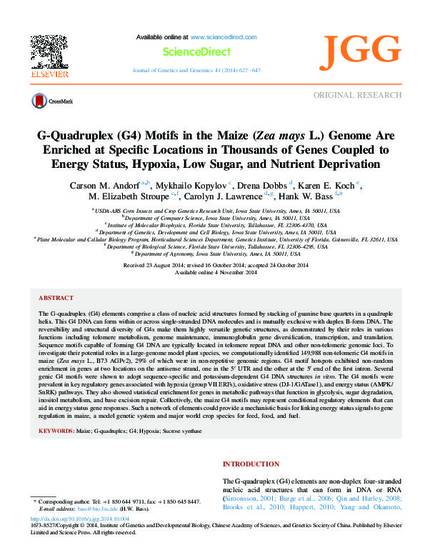
Article
G-Quadruplex (G4) Motifs in the Maize (Zea mays L.) Genome Are Enriched at Specific Locations in Thousands of Genes Coupled to Energy Status, Hypoxia, Low Sugar, and Nutrient Deprivation
Journal of Genetics and Genomics
Document Type
Article
Disciplines
Publication Version
Published Version
Publication Date
1-1-2014
DOI
10.1016/j.jgg.2014.10.004
Abstract
The G-quadruplex (G4) elements comprise a class of nucleic acid structures formed by stacking of guanine base quartets in a quadruple helix. This G4 DNA can form within or across single-stranded DNA molecules and is mutually exclusive with duplex B-form DNA. The reversibility and structural diversity of G4s make them highly versatile genetic structures, as demonstrated by their roles in various functions including telomere metabolism, genome maintenance, immunoglobulin gene diversification, transcription, and translation. Sequence motifs capable of forming G4 DNA are typically located in telomere repeat DNA and other non-telomeric genomic loci. To investigate their potential roles in a large-genome model plant species, we computationally identified 149,988 non-telomeric G4 motifs in maize (Zea mays L., B73 AGPv2), 29% of which were in non-repetitive genomic regions. G4 motif hotspots exhibited non-random enrichment in genes at two locations on the antisense strand, one in the 5′ UTR and the other at the 5′ end of the first intron. Several genic G4 motifs were shown to adopt sequence-specific and potassium-dependent G4 DNA structures in vitro. The G4 motifs were prevalent in key regulatory genes associated with hypoxia (group VII ERFs), oxidative stress (DJ-1/GATase1), and energy status (AMPK/SnRK) pathways. They also showed statistical enrichment for genes in metabolic pathways that function in glycolysis, sugar degradation, inositol metabolism, and base excision repair. Collectively, the maize G4 motifs may represent conditional regulatory elements that can aid in energy status gene responses. Such a network of elements could provide a mechanistic basis for linking energy status signals to gene regulation in maize, a model genetic system and major world crop species for feed, food, and fuel.
Rights
Works produced by employees of the U.S. Government as part of their official duties are not copyrighted within the U.S. The content of this document is not copyrighted.
Language
en
File Format
application/pdf
Citation Information
Carson M. Andorf, Mykhailo Kopylov, Drena Dobbs, Karen E. Koch, et al.. "G-Quadruplex (G4) Motifs in the Maize (Zea mays L.) Genome Are Enriched at Specific Locations in Thousands of Genes Coupled to Energy Status, Hypoxia, Low Sugar, and Nutrient Deprivation" Journal of Genetics and Genomics Vol. 41 Iss. 12 (2014) p. 627 - 647 Available at: http://works.bepress.com/drena-dobbs/16/

This article is from Journal of Genetics and Genomics 41 (2014): 627, doi: 10.1016/j.jgg.2014.10.004.